Optimal Serum Ferritin Levels for Iron Deficiency Anemia during Oral Iron Therapy (OIT) in Japanese Hemodialysis Patients with Minor Inflammation and Benefit of Intravenous Iron Therapy for OIT-Nonresponders
Abstract
1. Introduction
2. Materials and Methods
Statistical Analysis
3. Results
4. Discussion
5. Conclusions
Acknowledgments
Author Contributions
Conflicts of Interest
References
- Vaziri, N.D. Safety issues in iron treatment in CKD. Semin. Nephrol. 2016, 36, 112–118. [Google Scholar] [CrossRef] [PubMed]
- Lopez, A.; Cacoub, P.; Macdougall, I.C.; Peyrin-Biroulet, L. Iron deficiency anaemia. Lancet 2016, 387, 907–916. [Google Scholar] [CrossRef]
- The Kidney Disease: Improving Global Outcomes (KDIGO) Anemia Work Group. KDIGO clinical practice guideline for anemia in chronic kidney disease. Kidney Int. Suppl. 2012, 2, 279–335. [Google Scholar]
- Macdougall, I.C.; Bock, A.H.; Carrera, F.; Eckardt, K.U.; Gaillard, C.; Van Wyck, D.; Roubert, B.; Nolen, J.G.; Roger, S.D.; FIND-CKD Study Investigators. FIND-CKD: A randomized trial of intravenous ferric carboxymaltose versus oral iron in patients with chronic kidney disease and iron deficiency anaemia. Nephrol. Dial. Transplant. 2014, 29, 2075–2084. [Google Scholar] [CrossRef] [PubMed]
- Tsubakihara, Y.; Nishi, S.; Akiba, T.; Hirakata, H.; Iseki, K.; Kubota, M.; Kuriyama, S.; Komatsu, Y.; Suzuki, M.; Nakai, S.; et al. 2008 Japanese Society for Dialysis Therapy: Guidelines for renal anemia in chronic kidney disease. Ther. Apher. Dial. 2010, 14, 240–275. [Google Scholar] [CrossRef] [PubMed]
- Bazeley, J.; Bieber, B.; Li, Y.; Morgenstern, H.; de Sequera, P.; Combe, C.; Yamamoto, H.; Gallagher, M.; Port, F.K.; Robinson, B.M. C-reactive protein and prediction of 1-year mortality in prevalent hemodialysis patients. Clin. J. Am. Soc. Nephrol. 2011, 6, 2452–2461. [Google Scholar] [CrossRef] [PubMed]
- Kawaguchi, T.; Tong, L.; Robinson, B.M.; Sen, A.; Fukuhara, S.; Kurokawa, K.; Canaud, B.; Lameire, N.; Port, F.K.; Pisoni, R.L. C-reactive protein and mortality in hemodialysis patients: The Dialysis Outcomes and Practice Patterns Study (DOPPS). Nephron Clin. Pract. 2011, 117, c167–c178. [Google Scholar] [CrossRef] [PubMed]
- Albaramki, J.; Hodson, E.M.; Craig, J.C.; Webster, A.C. Parenteral versus oral iron therapy for adults and children with chronic kidney disease. Cochrane Database Syst. Rev. 2012, 18, CD007857. [Google Scholar] [CrossRef] [PubMed]
- Rostoker, G.; Griuncelli, M.; Loridon, C.; Magna, T.; Janklewicz, P.; Drahi, G.; Dahan, H.; Cohen, Y. Maximal standard dose of parenteral iron for hemodialysis patients: An MRI-based decision tree learning analysis. PLoS ONE 2014, 9, e115096. [Google Scholar] [CrossRef] [PubMed]
- Rostoker, G.; Griuncelli, M.; Loridon, C.; Magna, T.; Machado, G.; Drahi, G.; Dahan, H.; Janklewicz, P.; Cohen, Y. Reassessment of iron biomarkers for prediction of dialysis iron overload: An MRI study. PLoS ONE 2015, 10, e0132006. [Google Scholar] [CrossRef] [PubMed]
- Bailie, G.R.; Larkina, M.; Goodkin, D.A.; Li, Y.; Pisoni, R.L.; Bieber, B.; Mason, N.; Tong, L.; Locatelli, F.; Marshall, M.R.; et al. Data from the Dialysis Outcomes and Practice Patterns Study validate an association between high intravenous iron doses and mortality. Kidney Int. 2015, 87, 162–168. [Google Scholar] [CrossRef] [PubMed]
- Kuo, K.L.; Hung, S.C.; Lin, Y.P.; Tang, C.F.; Lee, T.S.; Lin, C.P.; Tarng, D.C. Intravenous ferric chloride hexahydrate supplementation induced endothelial dysfunction and increased cardiovascular risk among hemodialysis patients. PLoS ONE 2012, 7, e50295. [Google Scholar] [CrossRef] [PubMed]
- Luo, J.; Jensen, D.E.; Maroni, B.J.; Brunelli, S.M. Spectrum and burden of erythropoiesis-stimulating agent hyporesponsiveness among contemporary hemodialysis patients. Am. J. Kidney Dis. 2016, 68, 763–771. [Google Scholar] [CrossRef] [PubMed]
- Ogawa, C.; Tsuchiya, K.; Kanda, F.; Maeda, T. Low levels of serum ferritin lead to adequate hemoglobin levels and good survival in hemodialysis patients. Am. J. Nephrol. 2014, 40, 561–570. [Google Scholar] [CrossRef] [PubMed]
- Del Vecchio, L.; Longhi, S.; Locatelli, F. Safety concerns about intravenous iron therapy in patients with chronic kidney disease. Clin. Kidney J. 2016, 9, 260–267. [Google Scholar] [CrossRef] [PubMed]
- Nakanishi, T.; Kuragano, T.; Nanami, M.; Otaki, Y.; Nonoguchi, H.; Hasuike, Y. Importance of ferritin for optimizing anemia therapy in chronic kidney disease. Am. J. Nephrol. 2010, 32, 439–446. [Google Scholar] [CrossRef] [PubMed]
- Łukaszyk, E.; Łukaszyk, M.; Koc-Żórawska, E.; Tobolczyk, J.; Bodzenta-Łukaszyk, A.; Małyszko, J. Iron status and inflammation in early stages of chronic kidney disease. Kidney Blood Press. Res. 2015, 40, 366–373. [Google Scholar] [CrossRef] [PubMed]
- Kopelman, R.C.; Smith, L.; Peoples, L.; Biesecker, R.; Rizkala, A.R. Functional iron deficiency in hemodialysis patients with high ferritin. Hemodial. Int. 2007, 11, 238–246. [Google Scholar] [CrossRef] [PubMed]
- Jenq, C.C.; Tian, Y.C.; Wu, H.H.; Hsu, P.Y.; Huang, J.Y.; Chen, Y.C.; Fang, J.T.; Yang, C.W. Effectiveness of oral and intravenous iron therapy in haemodialysis patients. Int. J. Clin. Pract. 2008, 62, 416–422. [Google Scholar] [CrossRef] [PubMed]
- Kalra, P.A.; Bhandari, S.; Saxena, S.; Agarwal, D.; Wirtz, G.; Kletzmayr, J.; Thomsen, L.L.; Coyne, D.W. A randomized trial of iron isomaltoside 1000 versus oral iron in non-dialysis-dependent chronic kidney disease patients with anaemia. Nephrol. Dial. Transplant. 2016, 31, 646–655. [Google Scholar] [CrossRef] [PubMed]
- Agarwal, R.; Kusek, J.W.; Pappas, M.K. A randomized trial of intravenous and oral iron in chronic kidney disease. Kidney Int. 2015, 88, 905–914. [Google Scholar] [CrossRef] [PubMed]
- Fishbane, S.; Mathew, A.; Vaziri, N.D. Iron toxicity: Relevance for dialysis patients. Nephrol. Dial. Transplant. 2014, 29, 255–259. [Google Scholar] [CrossRef] [PubMed]
- Lenga, I.; Lok, C.; Marticorena, R.; Hunter, J.; Dacouris, N.; Goldstein, M. Role of oral iron in the management of long-term hemodialysis patients. Clin. J. Am. Soc. Nephrol. 2007, 2, 688–693. [Google Scholar] [CrossRef] [PubMed]
- Tsuchida, A.; Paudyal, B.; Paudyal, P.; Ishii, Y.; Hiromura, K.; Nojima, Y.; Komai, M. Effectiveness of oral iron to manage anemia in long-term hemodialysis patients with the use of ultrapure dialysate. Exp. Ther. Med. 2010, 1, 777–781. [Google Scholar] [CrossRef] [PubMed]
- Takasawa, K.; Takaeda, C.; Maeda, T.; Ueda, N. Hepcidin-25, mean corpuscular volume, and ferritin as predictors of response to oral iron supplementation in hemodialysis patients. Nutrients 2015, 7, 103–118. [Google Scholar] [CrossRef] [PubMed]
- Sanai, T.; Ono, T.; Fukumitsu, T. Beneficial effects of oral iron in Japanese patients on hemodialysis. Intern. Med. 2017, 56, 2395–2399. [Google Scholar] [CrossRef] [PubMed]
- Kalantar-Zadeh, K.; Regidor, D.L.; McAllister, C.J.; Michael, B.; Warnock, D.G. Time-dependent associations between iron and mortality in hemodialysis patients. J. Am. Soc. Nephrol. 2005, 16, 3070–3080. [Google Scholar] [CrossRef] [PubMed]
- Kovesdy, C.P.; Estrada, W.; Ahmadzadeh, S.; Kalantar-Zadeh, K. Association of markers of iron stores with outcomes in patients with nondialysis-dependent chronic kidney disease. Clin. J. Am. Soc. Nephrol. 2009, 4, 435–441. [Google Scholar] [CrossRef] [PubMed]
- Ramanathan, G.; Olynyk, J.K.; Ferrari, P. Diagnosing and preventing iron overload. Hemodial. Int. 2017, 21 (Suppl. 1), S58–S67. [Google Scholar] [CrossRef] [PubMed]
- Chauveau, P.; Level, C.; Lasseur, C.; Bonarek, H.; Peuchant, E.; Montaudon, D.; Vendrely, B.; Combe, C. C-reactive protein and procalcitonin as markers of mortality in hemodialysis patients: A 2-year prospective study. J. Ren. Nutr. 2003, 13, 137–143. [Google Scholar] [CrossRef] [PubMed]
- Jenq, C.C.; Hsu, C.W.; Huang, W.H.; Chen, K.H.; Lin, J.L.; Lin-Tan, D.T. Serum ferritin levels predict all-cause and infection-cause 1-year mortality in diabetic patients on maintenance hemodialysis. Am. J. Med. Sci. 2009, 337, 188–194. [Google Scholar] [CrossRef] [PubMed]
- Hasuike, Y.; Nonoguchi, H.; Tokuyama, M.; Ohue, M.; Nagai, T.; Yahiro, M.; Nanami, M.; Otaki, Y.; Nakanishi, T. Serum ferritin predicts prognosis in hemodialysis patients: The Nishinomiya study. Clin. Exp. Nephrol. 2010, 14, 349–355. [Google Scholar] [CrossRef] [PubMed]
- Maruyama, Y.; Yokoyama, K.; Yokoo, T.; Shigematsu, T.; Iseki, K.; Tsubakihara, Y. The different association between serum ferritin and mortality in hemodialysis and peritoneal dialysis patients using Japanese nationwide dialysis registry. PLoS ONE 2015, 10, e0143430. [Google Scholar] [CrossRef] [PubMed]
- Kim, T.; Streja, E.; Soohoo, M.; Rhee, C.M.; Eriguchi, R.; Kim, T.W.; Chang, T.I.; Obi, Y.; Kovesdy, C.P.; Kalantar-Zadeh, K. Serum ferritin variations and mortality in incident hemodialysis patients. Am. J. Nephrol. 2017, 46, 120–130. [Google Scholar] [CrossRef] [PubMed]
- Floege, J.; Gillespie, I.A.; Kronenberg, F.; Anker, S.D.; Gioni, I.; Richards, S.; Pisoni, R.L.; Robinson, B.M.; Marcelli, D.; Froissart, M.; et al. Development and validation of a predictive mortality risk score from a European hemodialysis cohort. Kidney Int. 2015, 87, 996–1008. [Google Scholar] [CrossRef] [PubMed]
- Shoji, T.; Niihata, K.; Fukuma, S.; Fukuhara, S.; Akizawa, T.; Inaba, M. Both low and high serum ferritin levels predict mortality risk in hemodialysis patients without inflammation. Clin. Exp. Nephrol. 2017, 21, 685–693. [Google Scholar] [CrossRef] [PubMed]
- Musanovic, A.; Trnacevic, S.; Mekic, M.; Musanovic, A. The influence of inflammatory markers and CRP predictive value in relation to the target hemoglobin level in patients on chronic hemodialysis. Med. Arch. 2013, 67, 361–364. [Google Scholar] [CrossRef] [PubMed]
- Miskulin, D.C.; Tangri, N.; Bandeen-Roche, K.; Zhou, J.; McDermott, A.; Meyer, K.B.; Ephraim, P.L.; Michels, W.M.; Jaar, B.G.; Crews, D.C.; et al. Intravenous iron exposure and mortality in patients on hemodialysis. Clin. J. Am. Soc. Nephrol. 2014, 9, 1930–1939. [Google Scholar] [CrossRef] [PubMed]
- Ueda, N.; Takasawa, K. Role of hepcidin-25 in chronic kidney disease: Anemia and beyond. Curr. Med. Chem. 2017, 24, 1417–1452. [Google Scholar] [CrossRef] [PubMed]
- McMahon, L.P.; Kent, A.B.; Kerr, P.G.; Healy, H.; Irish, A.B.; Cooper, B.; Kark, A.; Roger, S.D. Maintenance of elevated versus physiological iron indices in non-anaemic patients with chronic kidney disease: A randomized controlled trial. Nephrol. Dial. Transplant. 2010, 25, 920–926. [Google Scholar] [CrossRef] [PubMed]
- El-Khatib, M.; Duncan, H.J.; Kant, K.S. Role of C-reactive protein, reticulocyte haemoglobin content and inflammatory markers in iron and erythropoietin administration in dialysis patients. Nephrology 2006, 11, 400–404. [Google Scholar] [CrossRef] [PubMed]
- Chand, S.; Ward, D.G.; Ng, Z.Y.; Hodson, J.; Kirby, H.; Steele, P.; Rooplal, I.; Bantugon, F.; Iqbal, T.; Tselepis, C.; et al. Serum hepcidin-25 and response to intravenous iron in patients with non-dialysis chronic kidney disease. J. Nephrol. 2015, 28, 81–88. [Google Scholar] [CrossRef] [PubMed]
- Tovbin, D.; Schnaider, A.; Vorobiov, M.; Rogachev, B.; Basok, A.; Shull, P.; Novack, V.; Friger, M.; Avramov, D.; Zlotnik, M. Minor impairment of oral iron absorption in non-diabetic new dialysis patients. J. Nephrol. 2005, 18, 174–180. [Google Scholar] [PubMed]
- Kooistra, M.P.; Niemantsverdriet, E.C.; van Es, A.; Mol-Beermann, N.M.; Struyvenberg, A.; Marx, J.J. Iron absorption in erythropoietin-treated haemodialysis patients: Effects of iron availability, inflammation and aluminium. Nephrol. Dial. Transplant. 1998, 13, 82–88. [Google Scholar] [CrossRef] [PubMed]
- Sarafidis, P.A.; Rumjon, A.; MacLaughlin, H.L.; Macdougall, I.C. Obesity and iron deficiency in chronic kidney disease: The putative role of hepcidin. Nephrol. Dial. Transplant. 2012, 27, 50–57. [Google Scholar] [CrossRef] [PubMed]
- Aydin, Z.; Gursu, M.; Karadag, S.; Uzun, S.; Sumnu, A.; Doventas, Y.; Ozturk, S.; Kazancioglu, R. The relationship of prohepcidin levels with anemia and inflammatory markers in non-diabetic uremic patients: A controlled study. Ren. Fail. 2014, 36, 1253–1257. [Google Scholar] [CrossRef] [PubMed]
- Malyszko, J.; Malyszko, J.S.; Pawlak, K.; Mysliwiec, M. Hepcidin, iron status, and renal function in chronic renal failure, kidney transplantation, and hemodialysis. Am. J. Hematol. 2006, 81, 832–837. [Google Scholar] [CrossRef] [PubMed]
- Samouilidou, E.; Pantelias, K.; Petras, D.; Tsirpanlis, G.; Bakirtzi, J.; Chatzivasileiou, G.; Tzanatos, H.; Grapsa, E. Serum hepcidin levels are associated with serum triglycerides and interleukin-6 concentrations in patients with end-stage renal disease. Ther Apher Dial. 2014, 18, 279–283. [Google Scholar] [CrossRef] [PubMed]
- Mercadal, L.; Metzger, M.; Haymann, J.P.; Thervet, E.; Boffa, J.J.; Flamant, M.; Vrtovsnik, F.; Gauci, C.; Froissart, M.; Stengel, B.; et al. A 3-marker index improves the identification of iron disorders in CKD anaemia. PLoS ONE 2014, 9, e84144. [Google Scholar] [CrossRef] [PubMed]
- Tutal, E.; Sezer, S.; Bilgic, A.; Aldemir, D.; Turkoglu, S.; Demirel, O.; Ozdemir, N.; Haberal, M. Influence of oxidative stress and inflammation on rHuEPO requirements of hemodialysis patients with CRP values “in normal range”. Transplant. Proc. 2007, 39, 3035–3040. [Google Scholar] [CrossRef] [PubMed]
- Shinzato, T.; Abe, K.; Furusu, A.; Harada, T.; Shinzato, K.; Miyazaki, M.; Kohno, S. Serum pro-hepcidin level and iron homeostasis in Japanese dialysis patients with erythropoietin (EPO)-resistant anemia. Med. Sci. Monit. 2008, 14, CR431–CR437. [Google Scholar] [PubMed]
- Prats, M.; Font, R.; García, C.; Muñoz-Cortés, M.; Cabré, C.; Jariod, M.; Romeu, M.; Giralt, M.; Martinez-Vea, A. Oxidative stress markers in predicting response to treatment with ferric carboxymaltose in nondialysis chronic kidney disease patients. Clin. Nephrol. 2014, 81, 419–426. [Google Scholar] [CrossRef] [PubMed]
- Sakellariou, G. Do serum and red blood cell folate levels indicate iron response in hemodialysis patients? ASAIO J. 2006, 52, 163–168. [Google Scholar]
- Besarab, A.; Chernyavskaya, E.; Motylev, I.; Shutov, E.; Kumbar, L.M.; Gurevich, K.; Chan, D.T.; Leong, R.; Poole, L.; Zhong, M.; et al. Roxadustat (FG-4592): Correction of anemia in incident dialysis patients. J. Am. Soc. Nephrol. 2016, 27, 1225–1233. [Google Scholar] [CrossRef] [PubMed]
- Movafagh, S.; Raj, D.; Sanaei-Ardekani, M.; Bhatia, D.; Vo, K.; Mahmoudieh, M.; Rahman, R.; Kim, E.H.; Harralson, A.F. Hypoxia inducible factor 1: A urinary biomarker of kidney disease. Clin. Transl. Sci. 2017, 10, 201–207. [Google Scholar] [CrossRef] [PubMed]
- Kapoian, T.; O’Mara, N.B.; Carreon, M.; Gajary, A.; Rizkala, A.; Lefavour, G.; Sherman, R.A.; Walker, J. Iron indices and intravenous ferumoxytol: Time to steady-state. Ann. Pharmacother. 2012, 46, 1308–1314. [Google Scholar] [CrossRef] [PubMed]
- Pisani, A.; Riccio, E.; Sabbatini, M.; Andreucci, M.; Del Rio, A.; Visciano, B. Effect of oral liposomal iron versus intravenous iron for treatment of iron deficiency anaemia in CKD patients: A randomized trial. Nephrol. Dial. Transplant. 2015, 30, 645–652. [Google Scholar] [CrossRef] [PubMed]
- Lewis, J.B.; Sika, M.; Koury, M.J.; Chuang, P.; Schulman, G.; Smith, M.T.; Whittier, F.C.; Linfert, D.R.; Galphin, C.M.; Athreya, B.P.; et al. Ferric citrate controls phosphorus and delivers iron in patients on dialysis. J. Am. Soc. Nephrol. 2015, 26, 493–503. [Google Scholar] [CrossRef] [PubMed]
- Deira, J.; Martín, M.; Sánchez, S.; Garrido, J.; Núñez, J.; Tabernero, J.M. Evaluation of intestinal iron absorption by indirect methods in patients on hemodialysis receiving oral iron and recombinant human. Am. J. Kidney Dis. 2002, 39, 594–599. [Google Scholar] [CrossRef]
- Killip, S.; Bennett, J.M.; Chambers, M.D. Iron deficiency anemia. Am. Fam. Physician 2007, 75, 671–678. [Google Scholar] [PubMed]
- Zariwala, M.G.; Somavarapu, S.; Farnaud, S.; Renshaw, D. Comparison study of oral iron preparations using a human intestinal model. Sci. Pharm. 2013, 81, 1123–1139. [Google Scholar] [CrossRef] [PubMed]
- Kiss, J.E.; Brambilla, D.; Glynn, S.A.; Mast, A.E.; Spencer, B.R.; Stone, M.; Kleinman, S.H.; Cable, R.G.; National Heart, Lung, and Blood Institute (NHLBI) Recipient Epidemiology and Donor Evaluation Study-III (REDS-III). Oral iron supplementation after blood donation: A randomized clinical trial. JAMA 2015, 313, 575–583. [Google Scholar] [CrossRef] [PubMed]
- Al-Hawas, F.; Abdalla, A.H.; Popovich, W.; Mousa, D.H.; Al-Sulaiman, M.H.; Al-Khader, A.A. Use of i.v. iron saccharate in haemodialysis patients not responding to oral iron and erythropoietin. Nephrol. Dial. Transplant. 1997, 12, 2801–2802. [Google Scholar] [CrossRef] [PubMed]
- Canavese, C.; Bergamo, D.; Ciccone, G.; Burdese, M.; Maddalena, E.; Barbieri, S.; Thea, A.; Fop, F. Low-dose continuous iron therapy leads to a positive iron balance and decreased serum transferrin levels in chronic haemodialysis patients. Nephrol. Dial. Transplant. 2004, 19, 1564–1570. [Google Scholar] [CrossRef] [PubMed]
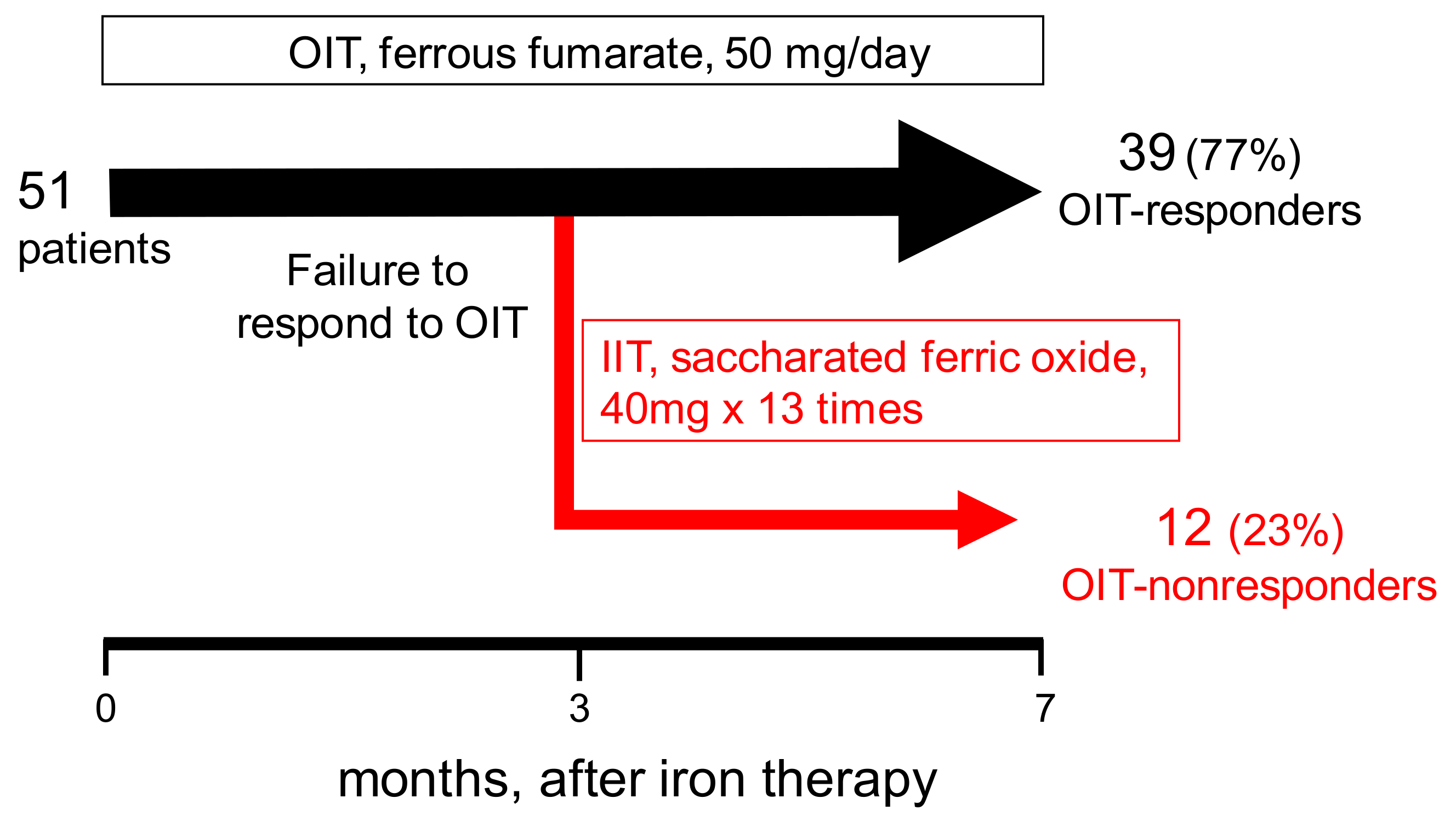
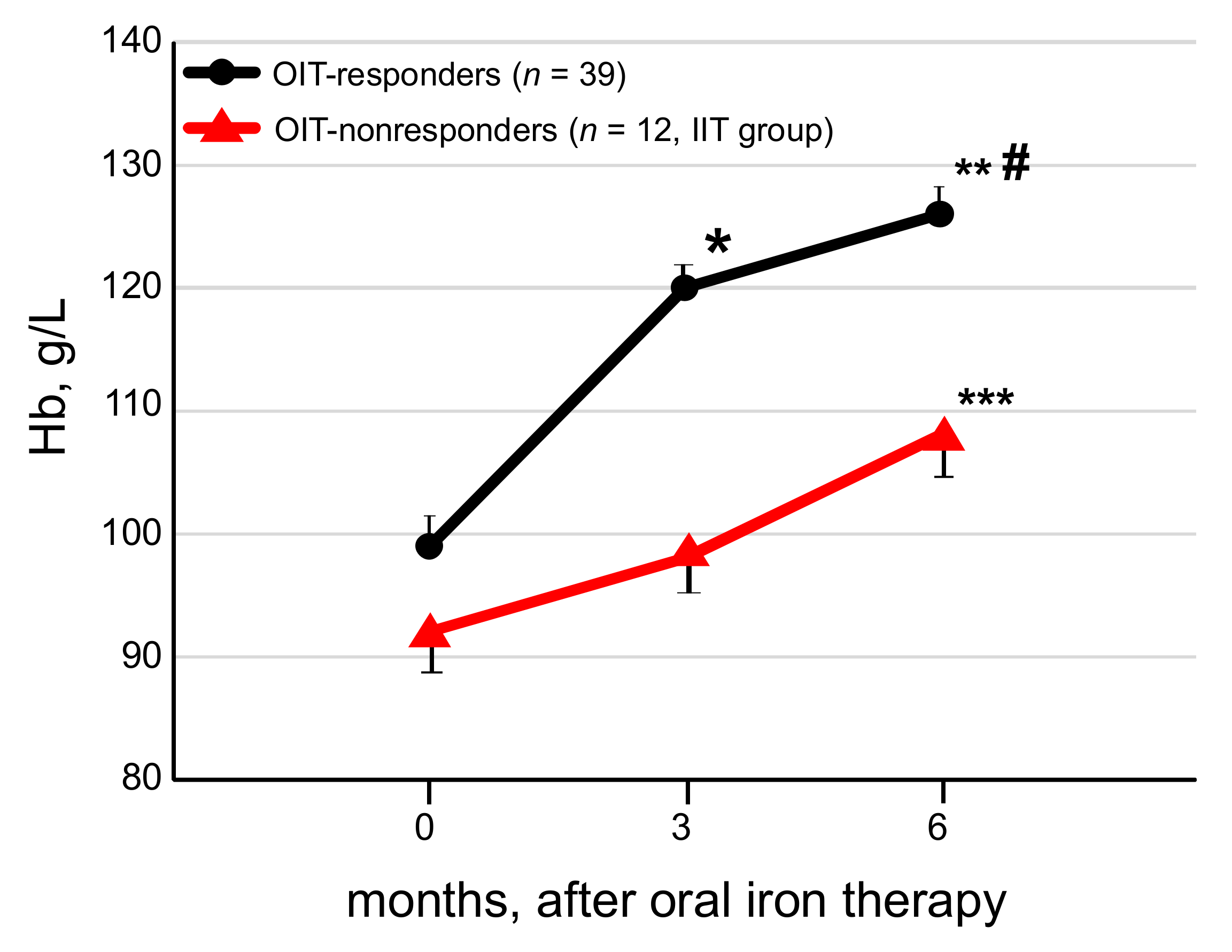
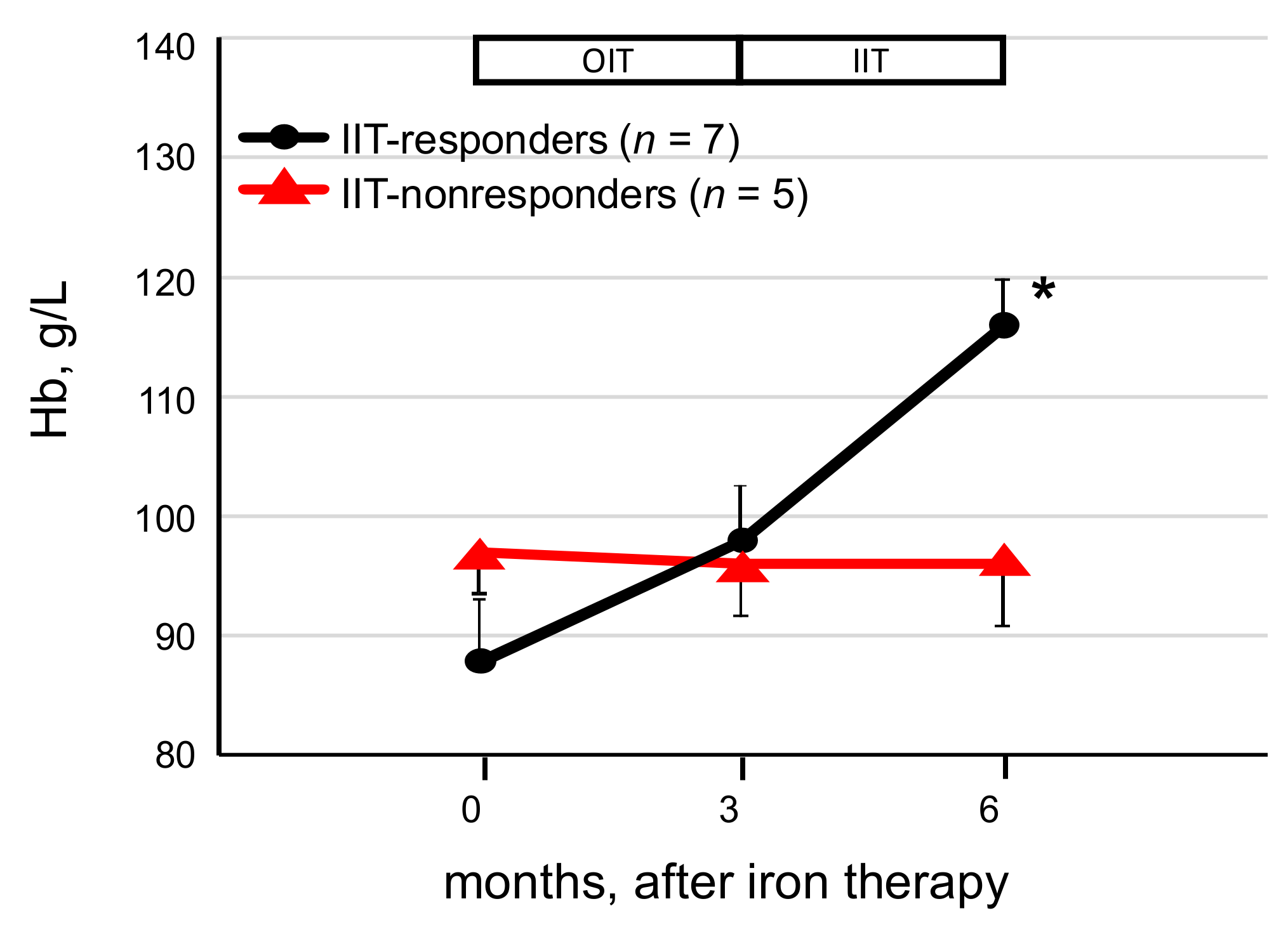
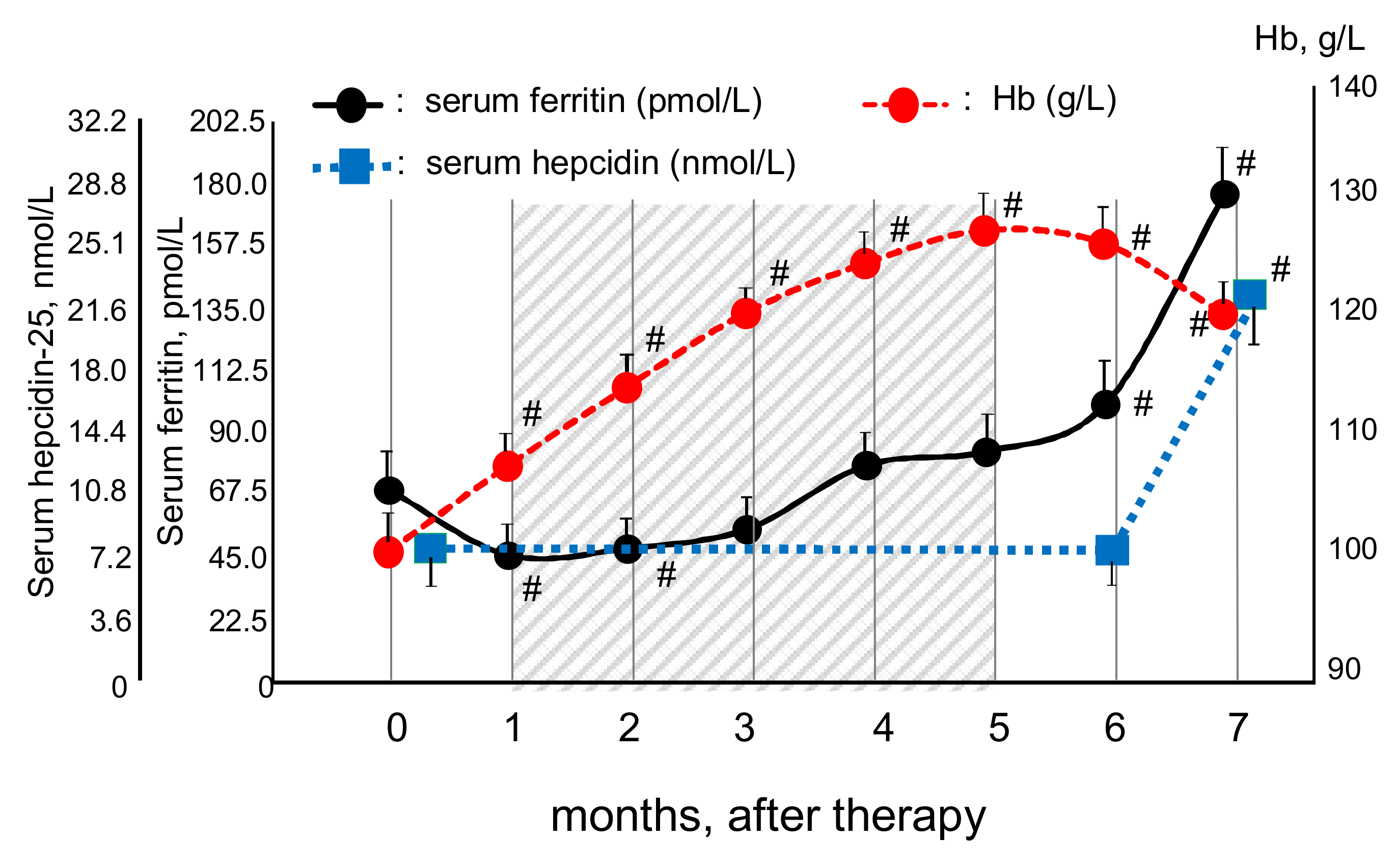
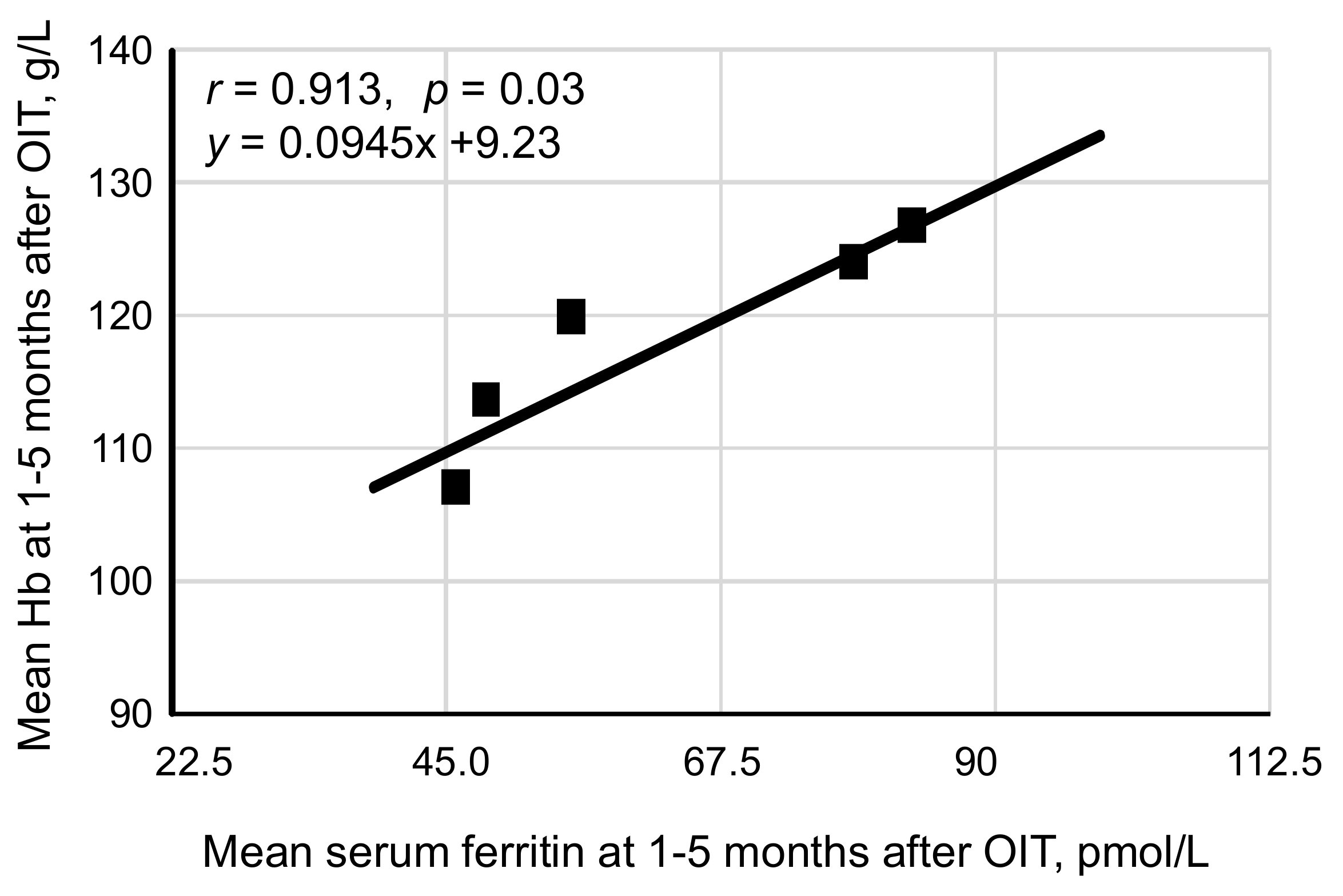
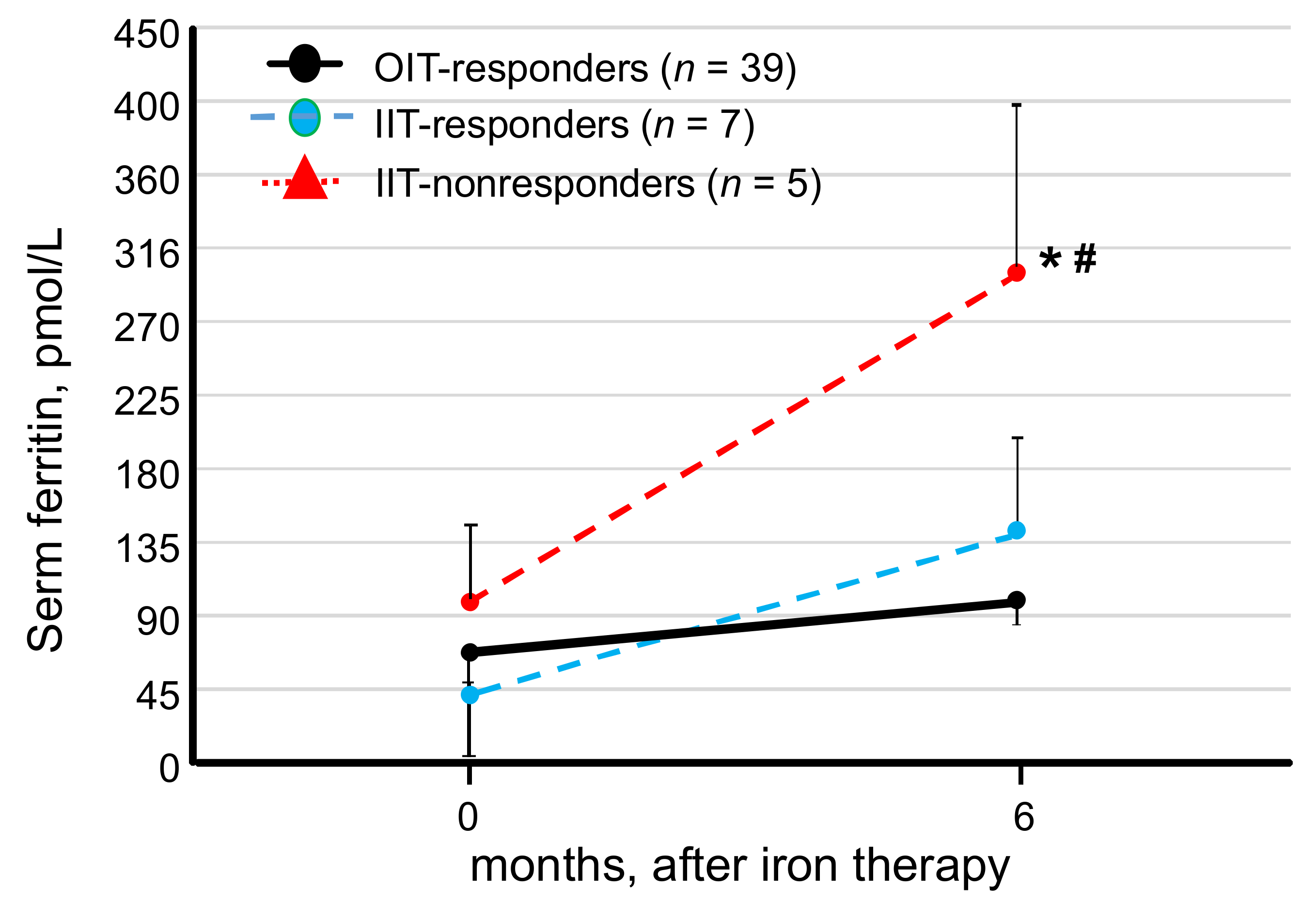
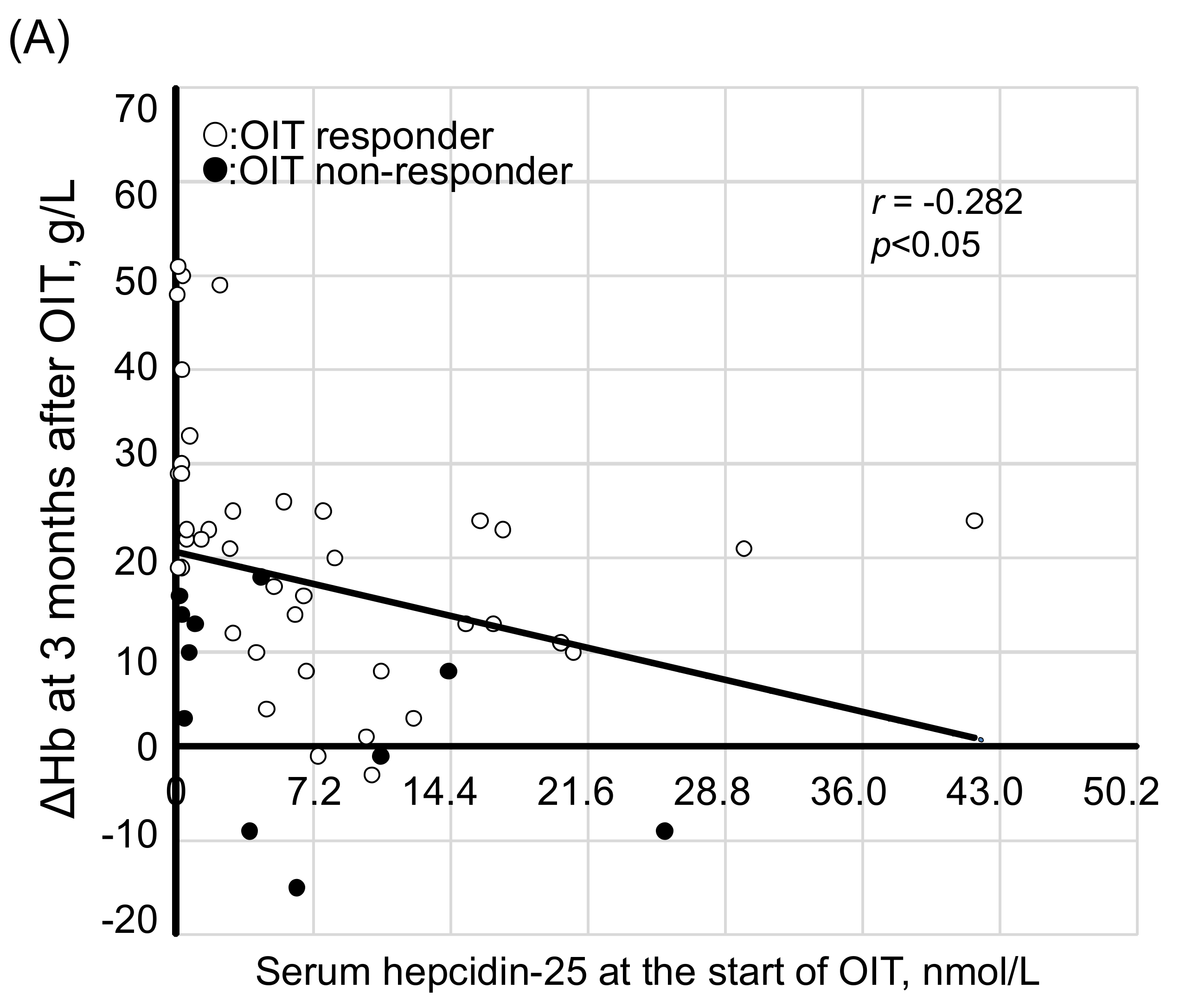
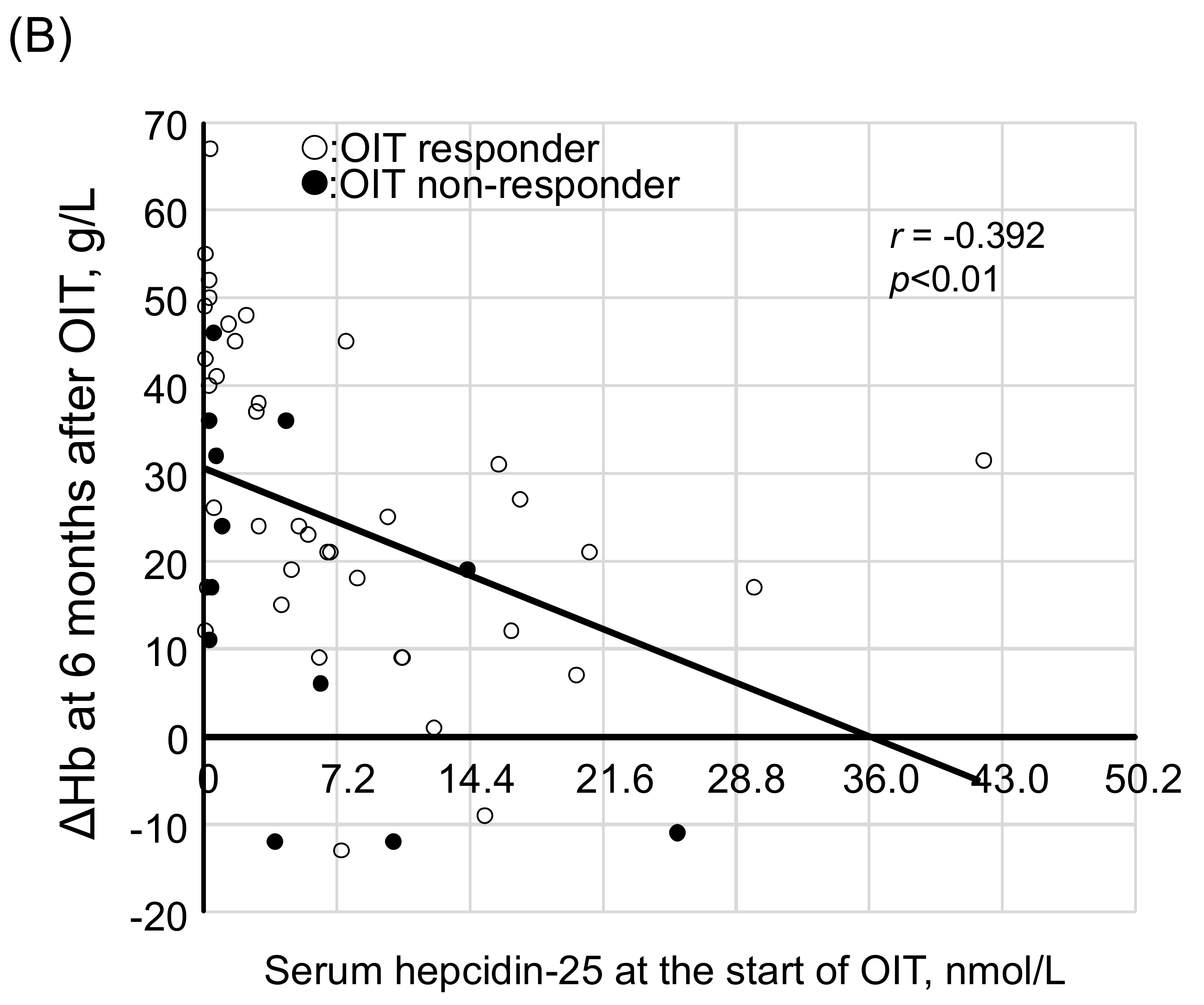
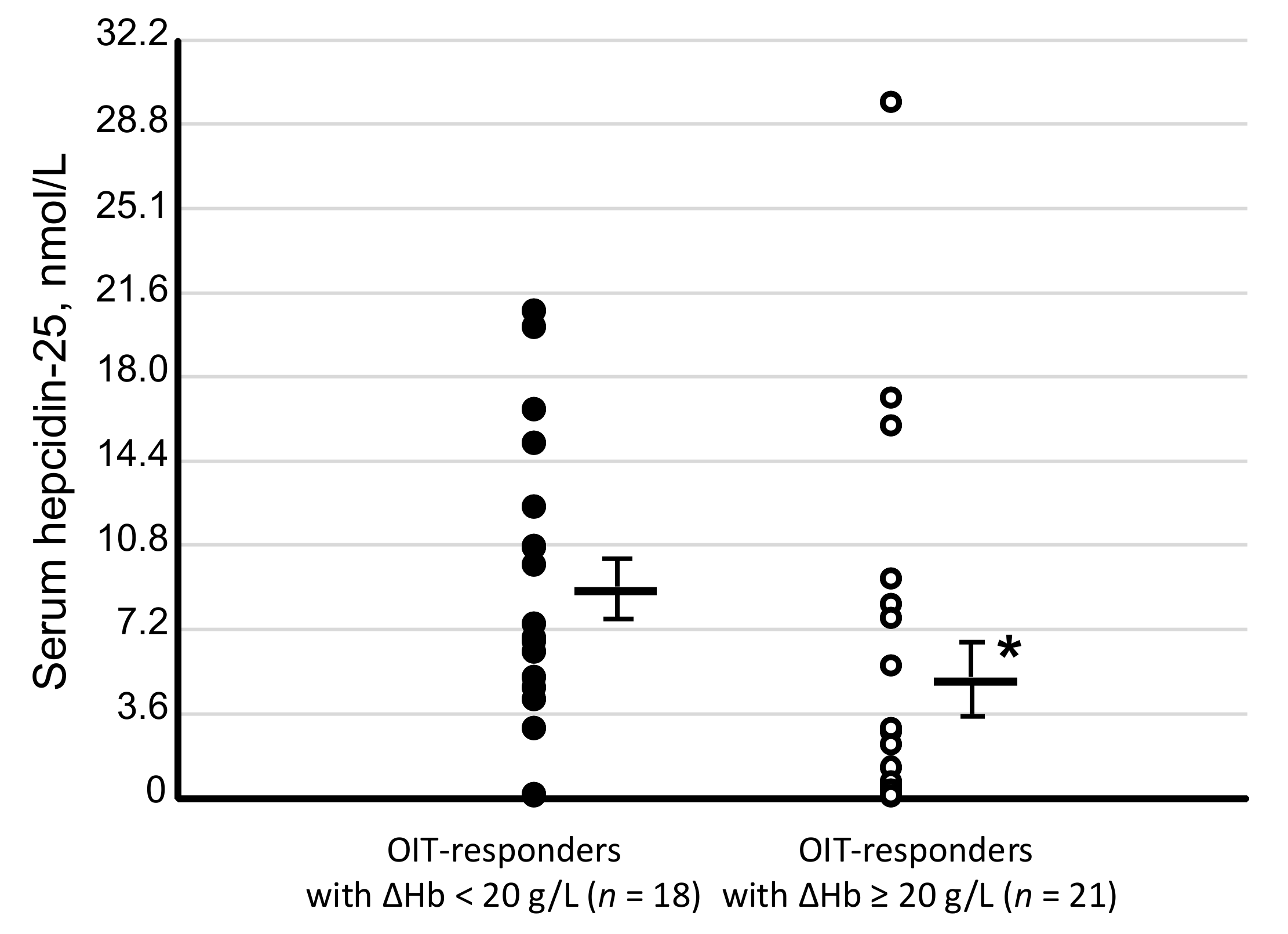
| OIT-Responders (n = 39) | OIT-Nonresponders (n = 12) | p Value | |
|---|---|---|---|
| Age (years) | 66.0 (18.0) | 62.5 (13.8) | 0.46 |
| Female (%) | 52 | 33 | 0.32 |
| Body mass index (kg/m2) | 21.3 (4.0) | 21.9 (3.6) | 0.84 |
| HD vintage (years) | 4.5 (10.5) | 4.0 (7.8) | 0.50 |
| spKt/V | 1.49 (0.4) | 1.35 (0.59) | 0.65 |
| Hb (g/L) | 10.3 (1.4) | 9.2 (1.3) * | 0.04 |
| MCV (fL) | 84.8 (8.1) | 85.9 (8.6) | 0.49 |
| Serum ferritin (pmol/L) | 39.8 (51.2) | 29.2 (53.4) | 0.47 |
| Serum iron (μmol/l) | 12.5 (10.7) | 8.3 (8.2) | 0.13 |
| TSAT (%) | 18.2 (14.5) | 15.5 (13.8) | 0.71 |
| Serum hepcidin (nmol/L) | 5.1 (10.1) | 2.8 (6.7) | 0.25 |
| Serum creatinine (μmol/L) | 1034 (309) | 919 (265) | 0.50 |
| Serum albumin (g/L) | 35 (5) | 36 (2) | 0.34 |
| Serum triglycerides (mmol/L) | 0.95 (0.44) | 1.42 (0.96) * | 0.02 |
| Serum calcium (mmol/L) | 2.4 (0.1) | 2.4 (0.4) | 0.35 |
| Serum phosphorus (mmol/L) | 1.7 (0.6) | 1.8 (0.5) | 0.66 |
| i-PTH (ng/L) | 62.0 (82.0) | 50.5 (84.5) | 0.62 |
| CRP (mg/L) | 0.4 (0.9) | 0.6 (0.8) | 0.69 |
| CERA dose (μg/week) | 150 (50) | 150 (62.5) | 0.73 |
| Comorbidities (%) | |||
| Diabetes mellitus | 32 | 33 | |
| Hypertension | 85 | 67 | |
| Coronary artery disease | 26 | 25 | |
| Congestive heart failure | 0 | 0 | |
| Vascular disease | 8 | 8 |
© 2018 by the authors. Licensee MDPI, Basel, Switzerland. This article is an open access article distributed under the terms and conditions of the Creative Commons Attribution (CC BY) license (http://creativecommons.org/licenses/by/4.0/).
Share and Cite
Takasawa, K.; Takaeda, C.; Wada, T.; Ueda, N. Optimal Serum Ferritin Levels for Iron Deficiency Anemia during Oral Iron Therapy (OIT) in Japanese Hemodialysis Patients with Minor Inflammation and Benefit of Intravenous Iron Therapy for OIT-Nonresponders. Nutrients 2018, 10, 428. https://doi.org/10.3390/nu10040428
Takasawa K, Takaeda C, Wada T, Ueda N. Optimal Serum Ferritin Levels for Iron Deficiency Anemia during Oral Iron Therapy (OIT) in Japanese Hemodialysis Patients with Minor Inflammation and Benefit of Intravenous Iron Therapy for OIT-Nonresponders. Nutrients. 2018; 10(4):428. https://doi.org/10.3390/nu10040428
Chicago/Turabian StyleTakasawa, Kazuya, Chikako Takaeda, Takashi Wada, and Norishi Ueda. 2018. "Optimal Serum Ferritin Levels for Iron Deficiency Anemia during Oral Iron Therapy (OIT) in Japanese Hemodialysis Patients with Minor Inflammation and Benefit of Intravenous Iron Therapy for OIT-Nonresponders" Nutrients 10, no. 4: 428. https://doi.org/10.3390/nu10040428
APA StyleTakasawa, K., Takaeda, C., Wada, T., & Ueda, N. (2018). Optimal Serum Ferritin Levels for Iron Deficiency Anemia during Oral Iron Therapy (OIT) in Japanese Hemodialysis Patients with Minor Inflammation and Benefit of Intravenous Iron Therapy for OIT-Nonresponders. Nutrients, 10(4), 428. https://doi.org/10.3390/nu10040428





